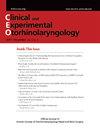Use of Skull Vibration-Induced Nystagmus in the Follow-up of Patients With Ménière Disease Treated With Intratympanic Gentamicin.
IF 3.4
3区 医学
Q1 OTORHINOLARYNGOLOGY
引用次数: 0
Abstract
Objectives. Ménière disease (MD) is an idiopathic disorder that affects hearing and inner ear balance. Intratympanic gentamicin (ITG) is recognized as an effective treatment for uncontrolled MD characterized by persistent vertigo attacks despite therapy. The video head impulse test (vHIT) and skull vibration-induced nystagmus (SVIN) are validated methods for evaluating vestibular function. A progressive linear relationship has been identified between the slow-phase velocity (SPV) of SVIN determined using a 100-Hz skull vibrator and the gain difference (healthy ear/affected ear) measured by vHIT. The aim of this study was to ascertain whether the SPV of SVIN was associated with the recovery of vestibular function following ITG treatment. Consequently, we sought to determine whether SVIN could predict the onset of new vertigo attacks in patients with MD who were treated with ITG. Methods. A prospective longitudinal case-control study was conducted. Several variables were recorded post-ITG and throughout the follow-up period, followed by statistical analyses. Two groups were compared: patients who experienced vertigo attacks 6 months after ITG and those who did not. Results. The sample comprised 88 patients diagnosed with MD who underwent ITG treatment. Of the 18 patients who experienced recurring vertigo attacks, 15 demonstrated gain recovery in the affected ear. However, all 18 patients exhibited a decrease in the SPV of SVIN. Conclusion. The SPV of SVIN may be more sensitive than vHIT in identifying the recovery of vestibular function following ITG administration. To our knowledge, this is the first study to illustrate the link between a reduction in SPV and the likelihood of vertigo episodes in patients with MD who have been treated with ITG.


鼓膜内庆大霉素治疗msamni病后颅骨振动诱发眼球震颤的随访研究。
目的:msamni病(MD)是一种影响听力和内耳平衡的特发性疾病。鼓膜内庆大霉素(ITG)被认为是一种有效的治疗不受控制的MD的特点是持续的眩晕发作,尽管治疗。验证了视频头部脉冲试验(vHIT)和颅骨振动诱发眼球震颤(SVIN)。方法:评估前庭功能。使用100 hz颅骨振动器测量的SVIN慢相速度(SPV)与vHIT测量的增益差(健康耳/患病耳)之间存在递进线性关系。本研究的目的是确定SVIN的SPV是否与ITG治疗后前庭功能的恢复有关。因此,我们试图确定SVIN是否可以预测接受ITG治疗的MD患者新的眩晕发作。方法:采用前瞻性纵向病例对照研究。在itg后和整个随访期间记录几个变量,然后进行统计分析。比较两组患者:ITG后6个月出现眩晕发作的患者和没有出现眩晕发作的患者。结果:样本包括88例诊断为MD并接受ITG治疗的患者。在18名反复出现眩晕发作的患者中,15名患者表现出受影响耳朵的恢复。然而,18例患者均表现出SVIN的SPV降低。结论:SVIN的SPV可能比vHIT更能识别ITG后前庭功能的恢复情况。据我们所知,这是第一个阐明在接受ITG治疗的MD患者中SPV减少与眩晕发作可能性之间联系的研究。
本文章由计算机程序翻译,如有差异,请以英文原文为准。
求助全文
约1分钟内获得全文
求助全文
来源期刊
CiteScore
4.90
自引率
6.70%
发文量
49
审稿时长
6-12 weeks
期刊介绍:
Clinical and Experimental Otorhinolaryngology (Clin Exp Otorhinolaryngol, CEO) is an international peer-reviewed journal on recent developments in diagnosis and treatment of otorhinolaryngology-head and neck surgery and dedicated to the advancement of patient care in ear, nose, throat, head, and neck disorders. This journal publishes original articles relating to both clinical and basic researches, reviews, and clinical trials, encompassing the whole topics of otorhinolaryngology-head and neck surgery.
CEO was first issued in 2008 and this journal is published in English four times (the last day of February, May, August, and November) per year by the Korean Society of Otorhinolaryngology-Head and Neck Surgery. The Journal aims at publishing evidence-based, scientifically written articles from different disciplines of otorhinolaryngology field.
The readership contains clinical/basic research into current practice in otorhinolaryngology, audiology, speech pathology, head and neck oncology, plastic and reconstructive surgery. The readers are otolaryngologists, head and neck surgeons and oncologists, audiologists, and speech pathologists.

 求助内容:
求助内容: 应助结果提醒方式:
应助结果提醒方式:


